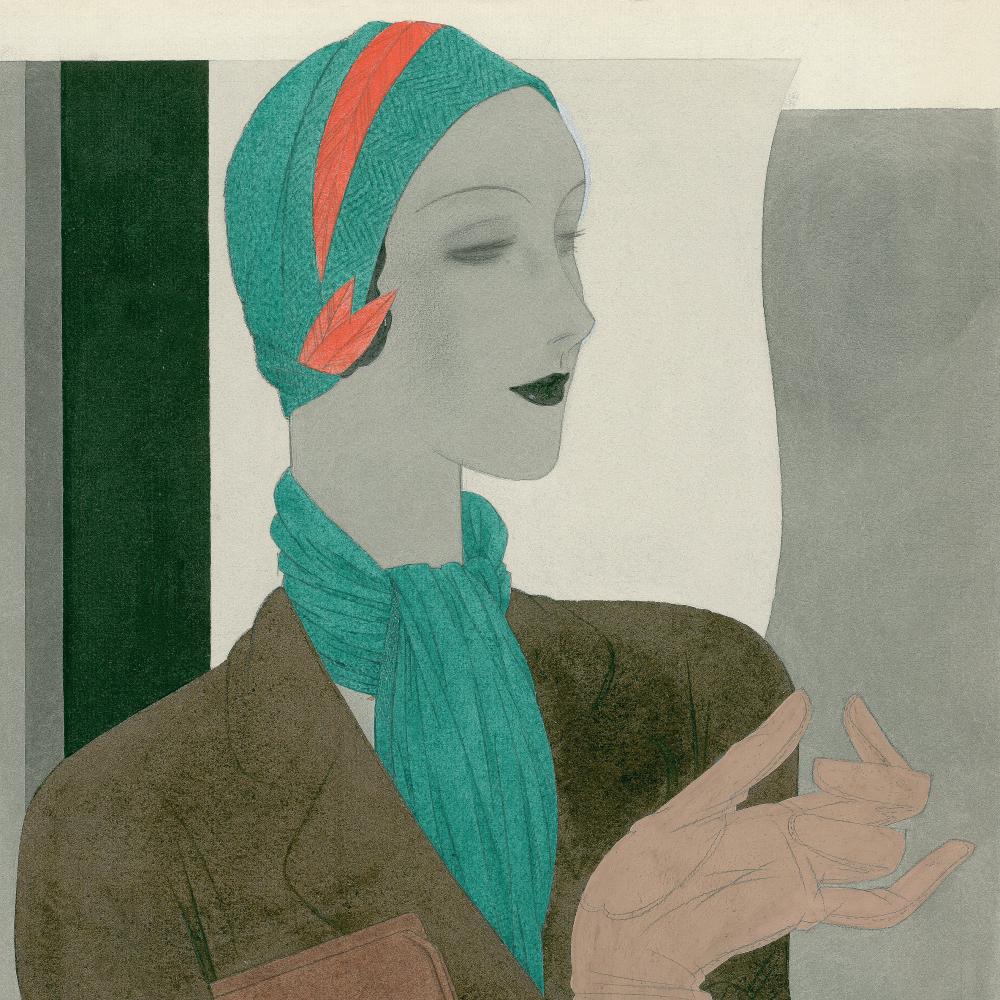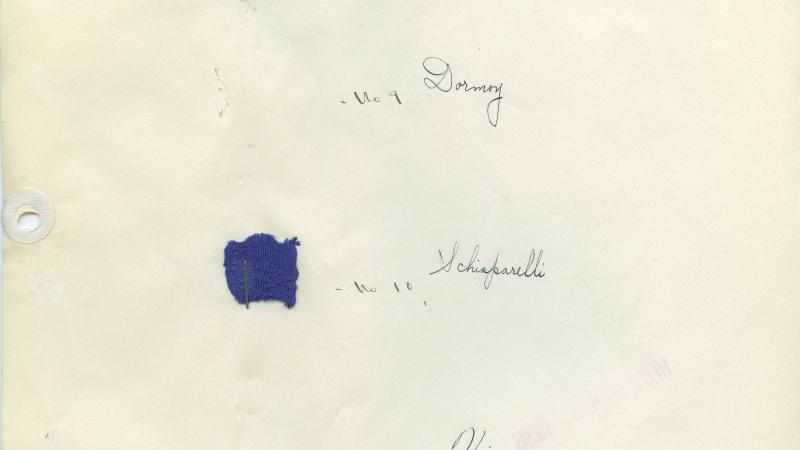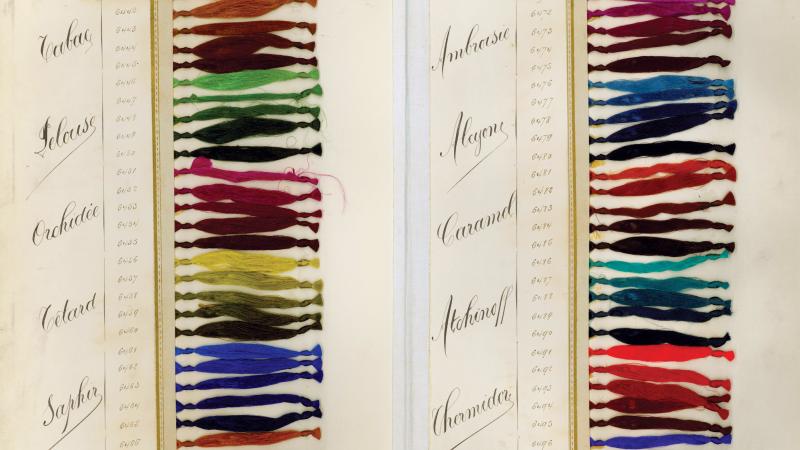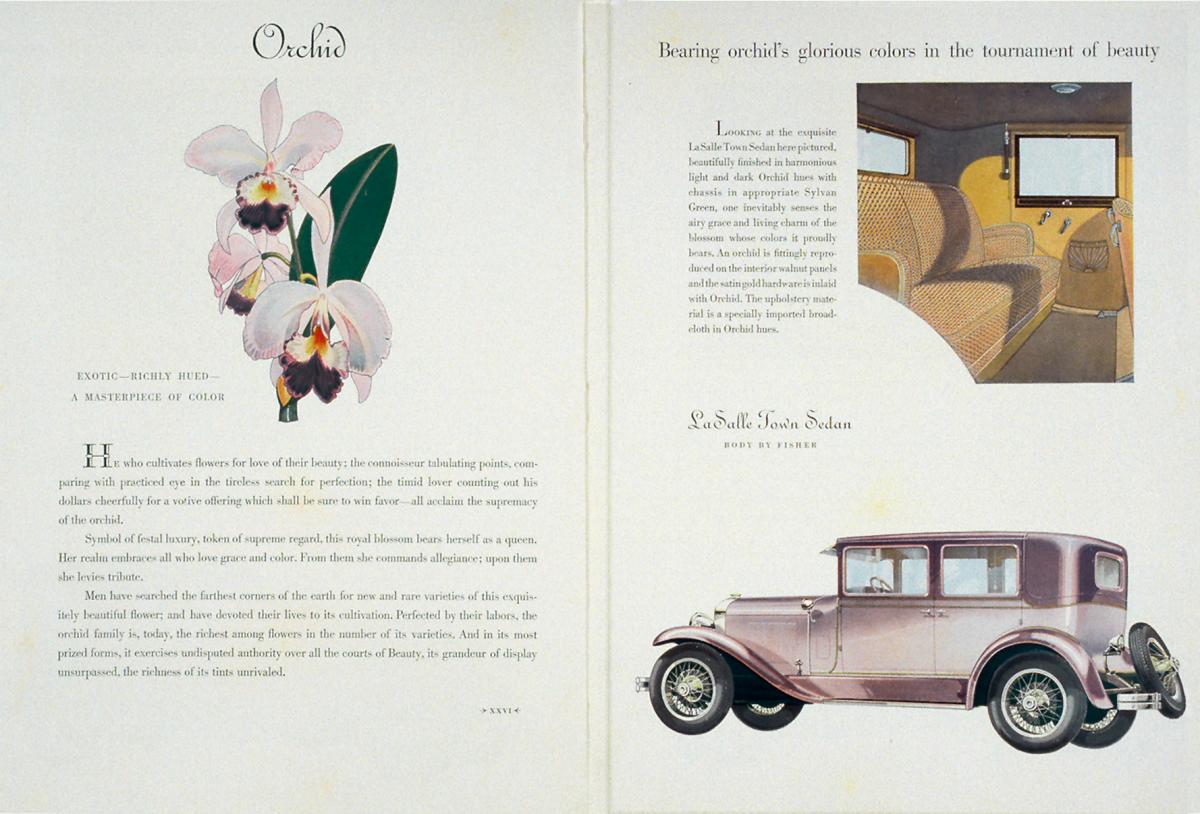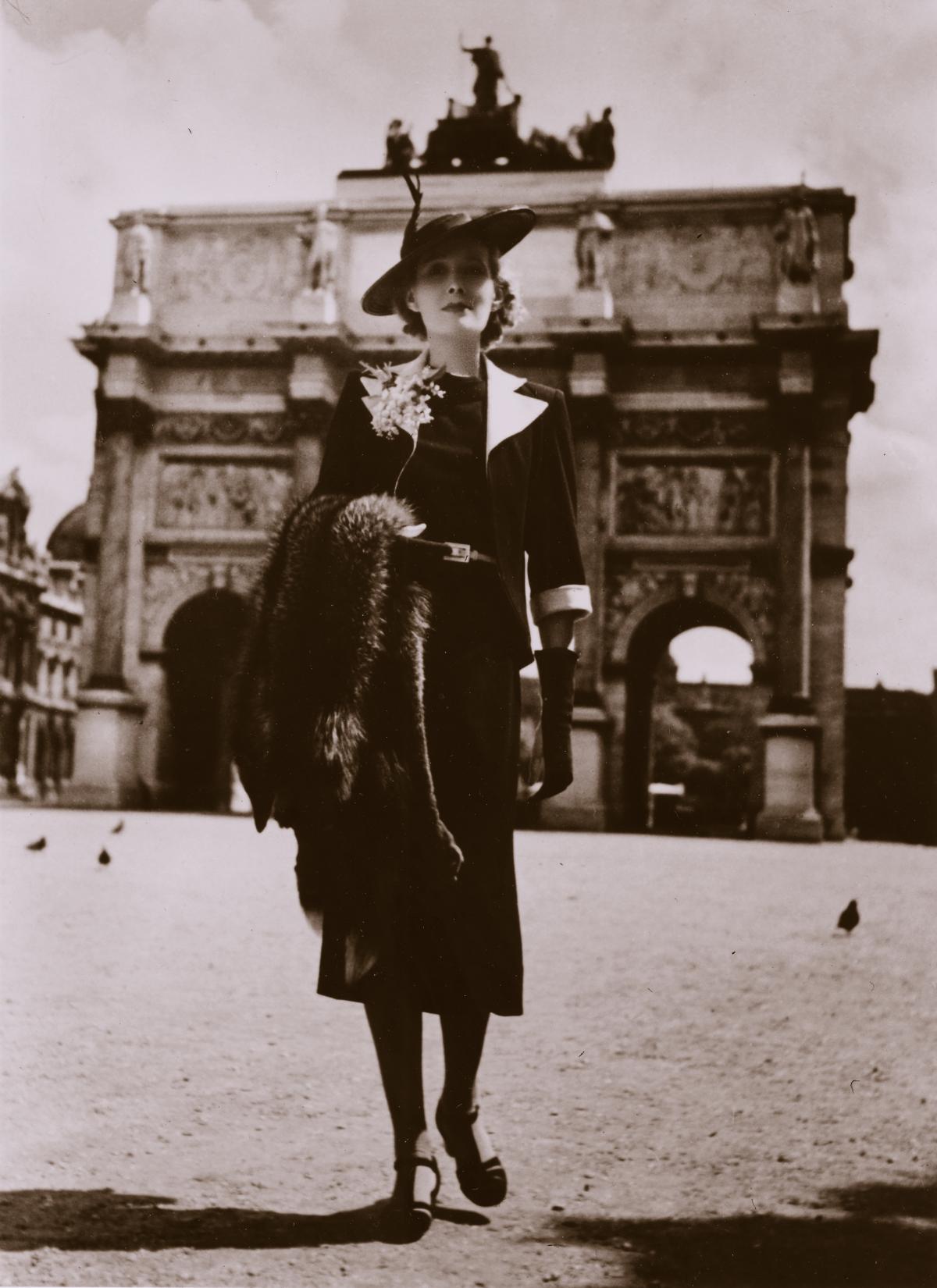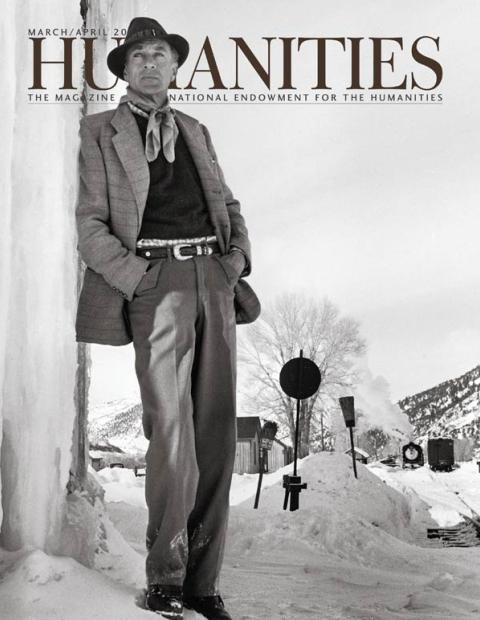Every fashionista remembers the scene. In The Devil Wears Prada, aspiring journalist Andrea Sachs, slumming it as a personal assistant to fashion editor Miranda Priestly, sniggers as the magazine staff banters over which “stuff” to put in a photo shoot. With catlike speed and a world-weary delivery, Priestly sizes up Andrea’s lumpy blue sweater and explains that it isn’t just blue or Turquoise or Lapis, but Cerulean, introduced by Paris designer Oscar de la Renta in 2002. From the catwalk, Cerulean Blue attracted the attention of several other designers and eventually found its way to mass retailers like Casual Corner, where proletarians like Andrea shop for bargains. “It’s sort of comical how you think you’ve made a choice that exempts you from the fashion industry,” Priestly concludes, “when in fact, you’re wearing a sweater that was selected for you by the people in this room.”
Cerulean Blue. It’s a striking name for a striking hue, but it isn’t a color that Oscar de la Renta invented. In 1999, the American color authority, Pantone, Inc., selected Cerulean Blue, described as the color of the sky on a serene, crystal clear day, as the “official color for the millennium.” Pantone is one of several global color consultancies that help big businesses like Apple, Mattel, and Nike make color choices for product development.
As colorists forecast, they must anticipate changes in taste several years in advance. They take into consideration the lead time needed for dye manufacturers to secure raw materials and negotiate contracts with suppliers, and the relentless shifts in consumer tastes. So, when Oscar de la Renta draped his fabulous Cerulean Blue gown, he may have been inspired by a Pantone color chip created well before the millennium. What seemed cutting edge on the Paris catwalk had, in fact, been imagined years earlier by color forecasters laboring over fabric swatches and paint chips somewhere in New Jersey.
None of this would have been possible without a confluence of circumstances that linked English ingenuity, German chemistry, French fashion, and American entrepreneurship. The Germans perfected reliable dyes, while the French created high fashion. For decades, the New York fashion industry copied the Europeans, until two American women transformed the business by setting color standards for manufacturers and scooping the Paris prognosticators.
Despite its curious name, there’s nothing strange or mysterious about the process that created Cerulean Blue. Color forecasting is a profession with a long history, going back to the late 1800s when French textile mills first issued color cards. These foldout books, made from paper and ribbon samples, showed what colors were popular among Paris dressmakers and milliners in the current season. On this side of the Atlantic, French color cards became valuable tools for textile mills, tanneries, straw makers, and feather importers—the industries that supplied the ready-to-wear business, hatmakers, and shoe factories. Manufacturers matched their dye lots to a particular shade card, ensuring that the thread used to sew a pair of fine kid gloves matched the color of the leather, or that Porcelaine Blue was really Porcelaine Blue.
The history of reliable colors that don’t fade in sunlight or streak when washed dates to Victorian England, when teenaged chemist William Perkin stumbled across a new purple dye while running experiments to synthesize quinine in 1856. Perkin’s mauveine ignited a chemical revolution, launching the synthetic dye industry.
Before this, dyes were made only from natural materials like plants and shells, and most faded over time. Since ancient times, the people of Tyre, in what is now Lebanon, had made purple dye from the ingredient found only in two types of rare mollusks that live along the eastern Mediterranean coast, making this expensive color fit only for the robes of kings and princes. The new synthetic dyes, inexpensively manufactured from coal tar that didn’t run or fade, changed how purple was made. Perkin started his own company, making the dyes that gave the 1850s and 1860s their nickname, the “mauve decades.” After Empress Eugénie and Queen Victoria wore mauveine dresses, hoop-skirted ladies made purple silk all the rage in middle-class parlors from Stockholm to Cincinnati.
While the English discovered mauveine, the Germans created the world-class chemical industry that made synthetic dyes the colorants of choice for textile mills in Europe and North America. After unification in the nineteenth century, the German state fostered innovation with a strong patent system, funding to research universities, and encouragement to cartels. By World War I, Germany supplied 90 percent of the dyes used by the American textile industry.
Across the Rhine in France, Paris achieved a similar monopoly in fashion. During the 1850s, an English transplant, Charles Frederick Worth, revolutionized the craft of French dressmaking and turned it into an art. The wealthy French had always loved fine clothes—the silk waistcoats and delicate slippers that separated the posh from the plain. Worth capitalized on elite taste, creating haute couture, a design and marketing system authorized by the French government to create exclusive designs for wealthy clients. On the eve of the First World War, Paris was the world’s undisputed fashion capital, setting trends that were copied from Moscow to New York. Paris designers not only dictated the silhouette, but their textile mills determined what colors were “in” or “out.”
Manhattan was America’s fashion hub. While the French dominated high style, the Americans catered to everyone else. New York was the center of the ready-to-wear industry, putting attractive clothes on the backs of shop girls and factory workers. Every year, American garment makers and retailers steamed across the Atlantic to see the Paris shows, returning with trunks full of couture models and color cards to copy. Surreptitiously, they also paid Parisian style experts to spy on the French, write reports, and secure samples of the newest fabrics. New York factories used the sewing machine, the division of labor, and French fashion secrets to produce the Paris look for less, marketed as “New York Style.”
World War I burst the transatlantic fashion bubble. The British blockade of the North Atlantic cut off supplies of German dyes, leaving the New York fashion industry high and dry. When they ran out of imported dyes, textile mills used substandard American materials that could only produce colors like Olive Drab and Battleship Gray. At the same time, Parisian color cards were unobtainable. In desperation, textile mills and retailers established the Textile Color Card Association to design an all-American palette that would be conceived and produced at home.
America’s first professional color forecaster, Margaret Hayden Rorke headed the association for nearly four decades. A former actress and suffragist, Rorke helped her male colleagues in manufacturing and retailing to understand what women expected of fashion. The association generated a Standard American color card, good for two to three years, and semiannual forecasts for ready-to-wear, millinery, leather, and hosiery. Members such as Gage Bros. & Co., the country’s largest hatmaker, or Sears, Roebuck & Co. knew women were discerning customers. They had seen shoppers stomp out of stores if the ribbons, feathers, or lace didn’t match a new Easter bonnet. The mail-order buyer who ordered five hundred silk dresses to complement his stock of Heliotrope shoes, belts, and gloves would be in the lurch if he got Orchid or Fuchsia. Disappointed flappers would send back the Fuchsia dress and look elsewhere. Color could make or break a retailer in the twenties, as the economic boom allowed more Americans to step through the portal of consumer society and buy ready-to-wear.
The war had taught Americans the dangers of depending on European expertise. Exploiting German patents that had been conscripted during the war by the U.S. government, chemical companies experimented with new paints, dyes, and pigments. By the mid-1920s, the assembly line looked like a rainbow. Macy’s promoted Color in the Kitchen to sell blue brooms and mottled mops. General Motors used True Blue as a weapon in their war against Ford. In 1930, Fortune magazine called this explosion nothing less than a “color revolution.”
Rorke managed this state of affairs for the association and was also one of its principal architects. The organization’s 1,500 paying members welcomed her monthly newsletters, color bulletins, and published forecasts. Nothing could force a knitting mill to comply with the rayon hosiery color card, but many mills found this information to be indispensable as they adjusted their production practices to the new American dyes. Other members, like the buyers from Sears or John Wanamaker’s department store, saw the cards as essential tools for keeping up with trends and anticipating consumer demand.
Every summer, Rorke went to Paris to see the couture openings, browse the boutiques, and watch the chic set in cafes. She returned to New York invigorated, sharing her ideas as she worked on committees to design shade cards for silk, leather, and hosiery. After seeing the stupendous Exposition Internationale des Arts Décoratifs et Industriels Modernes in 1925, she realized she needed up-to-the-minute news on French styles. Everyone’s eyes were fixed on Paris; giant chemical company DuPont sent its professional colorist to size up the Salon de l’Auto and chat up the couturiers. Determined not to be outdone, Rorke ventured into fashion espionage, hiring style spies to keep her abreast of the latest trends.
Between 1929 and 1940, Bettina Bedwell, a journalist at the Chicago Tribune’s Paris bureau, was Rorke’s main link to French fashion. Born on a Wyoming sheep ranch, Bedwell studied at the Chicago Art Institute before going to Paris to be a fashion illustrator. She landed at the Tribune, where she wrote a breezy column on Paris styles for Americans who could sew their own clothes from a Tribune Paris Pattern. In private life, Bedwell and her husband, painter Abraham Rattner, hobnobbed with the Cubist-Expressionist avant-garde. The couple lived in the creative enclave of Montmarte and socialized with Pablo Picasso, Joan Miró, Man Ray, Alberto Giacometti, Henri Matisse, and Marc Chagall. Rattner painted while Bedwell kept tabs on fashion until the impending Nazi invasion forced them to flee to New York.
Bedwell’s reputation as a columnist gave her entrée to exclusive restaurants, private parties, and society events. Her weekly letters to Rorke described what chic women liked. “Many Frenchwomen are getting away from black,” she explained in January 1936. “Navy blue, brown and red are the winter colors . . . worn by smart women now.” In June, she dined at the Spanish Embassy, sizing up the gowns of the Comtesse de Janzé and Princess Karam of Kapurthala, India. Earlier that year, on an unusually cold Sunday in April, Bedwell attended the horse races on the Paris outskirts hoping to see the latest styles, only to be disappointed to see that heavy fur coats hid the new Easter outfits.
The Tribune opened doors at the couture salons on avenue George V and at the wholesalers in le Marais, where Bedwell sniffed out tailors, dressmakers, and salespeople. Bedwell’s 1937 Yellow Dusk, a novel about drug smugglers and design pirates, vividly depicts the inner sanctum of the couture house. Her real-life covert operations focused not on who doped an American heiress, but on which colors Lucien Lelong or Elsa Schiaparelli fancied for the next season. Couturiers didn’t invent colors, but, with the help of the press, they could make or break a particular hue. Back in New York, the fashion-industrial complex—the magazines, department stores, dye makers, textile mills, and garment manufacturers—jumped when Paris blinked.
Bedwell and Rorke stoked this fashion machine from their little corners of Paris and New York. Bedwell tracked color trends from the conservative salons to the chic boutiques. She reported on the seasonal openings of all the leading couture houses: Coco Chanel, Lucien Lelong, Edward Molyneux, Jean Patou, Elsa Schiaparelli, and Madeleine Vionette. In May 1929, the French Industries of Fashion issued its fall forecast, described in Bedwell’s letters and swatches. Nearly every dressmaker drooled over Vert Amande, a light brownish-green tint. First adopted by Jenny, it was now a favorite of the House of Worth and Philippe et Gaston. Italian shoemaker André Perugia, whose rue du Faubourg-St. Honoré shop catered to Follies Bergère dancers, introduced sexy new dancing shoes in Vert Amande. Bedwell also picked out trends with potential Yankee appeal. In November, she sent Rorke a sheet of “new nail polish colors being worn by the ultra-fashionable in Paris”; Cutex, after seeing samples from another style service, she wrote, planned to introduce them back home.
In early 1936, Bedwell’s letters traced the flow of accessory colors from the couturiers to the boutiques and shops around Paris. Rorke relished these detailed reports because so many of her constituents made the leather, braid, ribbon, and plastics for hats, belts, shoes, and gloves. On a typical shopping trip, Bedwell visited Alexandrine de Paris at 10, rue Auber, described by the Los Angeles Times as “the most fashionable glove shop in Europe.” Close to the Opéra Garnier and the grands magasins, Mme. Alexandrine produced custom-made gloves, hats, and handbags for couturiers like Worth and Hollywood royalty like Gloria Swanson, capitalizing on the celebrity to market spin-offs to the general public. When Alexandrine scoffed at the idea of colored gloves, Bedwell reported it to Rorke but kept her eyes open. It soon became clear that the fashionable glover had misjudged. On the streets, Bedwell saw “several women, who while not outstandingly chic, were at least smart,” wearing red gloves, carrying red handbags, and wearing blue or black suits. With a nod to trickle-down fashion, Bedwell speculated that bright gloves would “undoubtedly be worn by the masses later,” both in Paris and New York. And they were.
Rorke didn’t use Bedwell’s correspondence to copy the Paris colors verbatim, but she matched the reports to her own recent forecasts. When the mail arrived, Rorke and her assistant, Estelle M. Tennis, poured over Bedwell’s swatches, comparing them to forecasts that the association had already published. Rorke used the French reports to enhance the association’s position as a color authority.
Rorke’s monthly newsletter, The Broadcast, vividly described how the French fashion industry had adopted colors just like the association’s Sistine, Empire, and Versailles blues. Privileging American tastes over French trends, the newsletter suggested that Rorke, color forecaster extraordinaire, had anticipated Paris fashions.
Whether in the 1930s or the twenty-first century, couturiers and colorists are part of the same transnational business system, with everyone struggling to understand the ebbs and flows of trends and tastes through the wider culture. Andrea’s Cerulean Blue sweater, the devil in Prada explains, had cost millions of dollars and created countless jobs. The process Miranda Priestly describes—how a color on a Paris runway becomes popular in American malls—gets to the heart and soul of the global fashion system. From Denver to Dubai, we all live and breathe fashion, making reality TV shows like Project Runway and What Not to Wear into cable success stories. Yet while everyone’s life is affected, most people don’t know how the fashion system works. Reality shows offer their own fantasy version of the fashion world in which a designer plus an idea plus a little bit of money and business savvy equal a successful product. The real business of fashion includes the coordination of so many players—from the color forecasters in New Jersey to the designer in Paris, from the buyer at Macy’s to the knockoff manufacturer in Hong Kong, from the red carpet parade to the oblivious shopper at the bargain basement. Perhaps that’s what makes the Cerulean sweater scene so memorable; it exposes how we are all part of the fashion system, like it or not.

